Treaty of Karlowitz
The Treaty of Karlowitz was signed on 26 January 1699 in Sremski Karlovci, in modern-day Serbia, concluding the Great Turkish War of 1683–1697 in which the Ottoman Empire had been defeated at the Battle of Zenta by the Holy League.[1] It marks the end of Ottoman control in much of Central Europe, with their first major territorial losses after centuries of expansion, and established the Habsburg Monarchy as the dominant power in the region.[2]
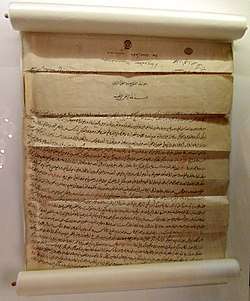 The official document of the treaty | |
| Context | Great Turkish War of 1683–1697 |
|---|---|
| Drafted | from 16 November 1698 |
| Signed | 26 January 1699 |
| Location | Karlowitz, Military Frontier, Habsburg Empire (now Sremski Karlovci, Serbia) |
| Signatories |
|
| Parties |
|
| Languages | |

Context and terms
Following a two-month congress between the Ottoman Empire on one side and the Holy League of 1684, a coalition of the Holy Roman Empire, the Polish–Lithuanian Commonwealth, the Republic of Venice and Peter the Great, Tsar of Russia,[3] a treaty was signed on 26 January 1699.
On the basis of uti possidetis, the treaty confirmed the then-current territorial holdings of each power.[2] The Habsburgs received from the Ottomans the Eğri Eyalet, Varat Eyalet, much of the Budin Eyalet, the northern part of the Temeşvar Eyalet and parts of the Bosnia Eyalet. This corresponded to much of Hungary, Croatia and Slavonia. The Principality of Transylvania remained nominally independent but was subject to the direct rule of Austrian governors.[2] Poland recovered Podolia, including the dismantled fortress at Kamaniçe.[2]
Venice obtained most of Dalmatia along with the Morea (the Peloponnese peninsula of southern Greece), though the Morea was restored to the Turks within 20 years by the Treaty of Passarowitz.[2] There was no agreement about the Holy Sepulchre, although it was discussed in Karlowitz.[4]
The Ottomans retained Belgrade, the Banat of Temesvár (modern Timișoara), as well as suzerainty over Wallachia and Moldavia. Negotiations with Muscovy for a further year under a truce agreed at Karlowitz culminated in the Treaty of Constantinople of 1700, whereby the Sultan ceded the Azov region to Peter the Great.[2] (Muscovy had to return these territories eleven years later following the failed Pruth River Campaign and the Treaty of the Pruth in 1711.)
Commissions were set up to devise the new borders between the Austrians and the Turks, with some parts disputed until 1703.[2] Largely through the efforts of the Habsburg commissioner Luigi Ferdinando Marsili, the Croatian and Bihać borders were agreed by mid-1700 and that at Temesvár by early 1701, leading to a border demarcated by physical landmarks for the first time.[2]
The acquisition of some 60,000 square miles (160,000 km2) of Hungarian territories at Karlowitz and of the Banat of Temesvár 18 years later by the Treaty of Passarowitz, enlarged Austrian State of the Habsburgs to its largest extent cementing Austria as a dominant regional power.[2] It increased in size by the acquisition of Polish territories in 1772 and 1795, Dalmatia in 1815 and Bosnia-Herzegovina in 1908.
Maps and images
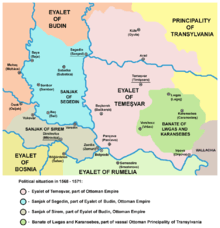

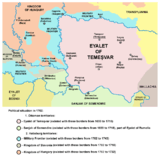
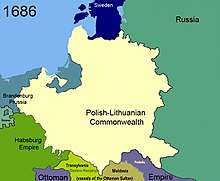 The Polish–Lithuanian Commonwealth in 1686, before the treaty
The Polish–Lithuanian Commonwealth in 1686, before the treaty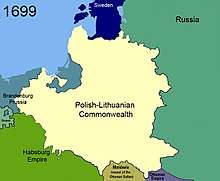 The Polish–Lithuanian Commonwealth in 1699, after the treaty. Note the Ottoman loss of territory at the bottom of the map.
The Polish–Lithuanian Commonwealth in 1699, after the treaty. Note the Ottoman loss of territory at the bottom of the map. Kapela mira (Peace Chapel), where the Treaty of Karlowitz was negotiated
Kapela mira (Peace Chapel), where the Treaty of Karlowitz was negotiated
Notes
- Nolan 2008, p. 27.
- Ágoston, Gábor (2010). "Treaty of Karlowitz". Encyclopedia of the Ottoman Empire. Infobase Publishing. pp. 309–10. ISBN 978-0816-06259-1.
- Robert Bideleux, Ian Jeffries, A History of Eastern Europe: Crisis and Change, Routledge, New York, 1998, p. 86. ISBN 0-415-16111-8
- János Nepomuk Jozsef Mailáth (gróf) (1848). Geschichte der europäischen Staaten (Geschichte des östreichischen Kaiserstaates, Band 4) [History of the European States (History of the Austrian Empire, volume 4)]. Hamburg: F. Perthes. pp. 262–63.
References
- Ćirković, Sima (2004). The Serbs. Malden: Blackwell Publishing.CS1 maint: ref=harv (link)
- Nolan, Cathal J. (2008). Wars of the Age of Louis XIV, 1650–1715: An Encyclopedia of Global Warfare. Greenwood Publishing.CS1 maint: ref=harv (link)
- Fodor, Pál; Dávid, Géza, eds. (2000). Ottomans, Hungarians, and Habsburgs in Central Europe: The Military Confines in the Era of Ottoman Conquest. BRILL.CS1 maint: ref=harv (link)
- Pešalj, Jovan (2010). "Early 18th-Century Peacekeeping: How Habsburgs and Ottomans Resolved Several Border Disputes after Karlowitz". Empires and Peninsulas: Southeastern Europe between Karlowitz and the Peace of Adrianople, 1699–1829. Berlin: LIT Verlag. pp. 29–42.CS1 maint: ref=harv (link)
External links
| Wikimedia Commons has media related to Treaty of Karlowitz. |